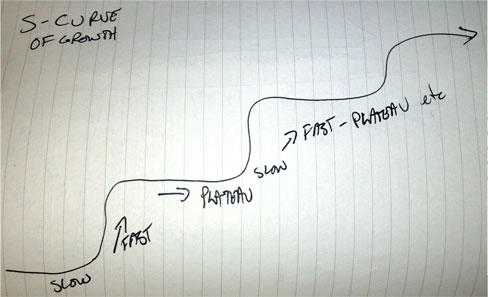Thoughts on Retaining Sales Talent
Thoughts on Retaining Sales Talent

Retaining Sales Talent
If this isn’t your first rodeo in managing a sales team, you’ll recognize that there are two challenges in building one. The first is obviously, building a high performance sales team. One that has the ability to adapt to rapid change, achieve extraordinary results and thrill clients by focusing on helping clients make good decisions. The other is retaining that sales talent and helping them through the inevitable plateaus that happen in the “S” Curve of growth.
To make sure we’re on the same page in regards to the S Curve of Growth, I define that with the following graph:
In my experience, growth builds up like pressure in a water bottle rocket with results coming in spurts followed by a plateau where the next level of growth brews. It’s in those plateaus where we lose our sales talent. Often because we don’t prepare them to expect a flattening of results after a period of above average gains.
In this note I am going to give you a few ideas on how to prepare your existing sales talent to not only be prepared for and expect rapid gains in results but on how to help them plan for the plateaus that will follow. During these flat result periods your high performance team can put in the time and effort required for them to experience the next period of big gains and combat the self-doubt and self-sabotage that leads to exits – whether they are forced or voluntary.
First things first. Turnover in sales is inevitable and a necessary by-product of a well run sales team. Dealing with increasing demands on quota, changes in market forces and compensation requires a high performance team to be on its toes. That coupled with the expectations of high performers that they are surrounded by other result oriented individuals requires the occasional turnover. If you’re running such a team, you are probably operating from a position of bench strength where you have candidates waiting in the wings for openings on your team. (the subject of another note at some point)
That said, turnover shouldn’t be celebrated as anything less than a failure of the organization to help your sales talent navigate the inevitable ups and downs that any results based position entails. With that in mind, let’s cover a few thoughts that can help your sales people on their professional journey.
Preparation for growth. One key to keeping your sales talent engaged and producing is the process we’ll call “preparation for success”. Unless you’ve recruited talent that has a habit of maxing out their comp plan, you’ll need to give your people the tools they need to manage success. Why? Well, for obvious reasons, if the individual is not going to experience the rewards of rapid growth and success, chances are you won’t keep them. So start by assuming they’re going to have success, know what that success looks like and start preparing them from the get-go on how to handle that success. That can include, but isn’t limited to, gains in income; increasing client demands; pipeline management; customer service issues; internal customer demands; rewards/recognition and the inevitable change to compensation plans.
Where this is most effective is in the hiring and initial training of new sales talent. Setting top line expectations in addition to drawing the minimum acceptable standards helps shape the sales reps expectations. They will arrive, get trained and experience some early success – success that most likely comes from their enthusiasm or existing contacts. That brief flicker of success is followed by a dip in performance as they drive through the valley of conscious competence. Your job is to get them through that dip/plateau to a place where they see confidence, client satisfaction and results. So, preparation for success includes planning for the ebb and flow of business. You know better than anyone what they’re going to go through so don’t keep it a secret. Which brings me to my next thought.
Preparation for the plateau. Once your sales talent has experienced strong results and the joy that comes with maximizing a compensation plan, there will come a time where the organizations growth requires your team to generate more results from their activity. In many case this is where you can expect your talent to have to deal with a plateau or perceived dip in performance. The effort, techniques, and activity that they have relied on are not longer producing the desired results. That leads to frustration and if they haven’t been prepared for such events they are left open to thoughts of life outside of your organization.
The best time to deal with result stagnation is before it happens. Again, during the hiring and training periods is a great time to set the stage for what will happen. (as some wise soul once told me, “what has happened will happen”) But the most effective time for dealing with a plateau is during a period of high times. Our ability to ignore the inevitability of good times coming to an end is well documented. An effective manager uses these times of prosperity to start planning for periods of flat results. (even if the only thing that’s flat are the commissions paid out due to changes in quota and compensation)
The time to “sharpen the saw” for your top performers is when the going is good. The time to encourage a strong personal financial plan is when the water’s high. The time to make changes to a client acquisition plan is when you’re stretching the current resources. The best time to borrow money is when you’re flush. You get the picture.
When you have a new sales professional that is experiencing success at a higher level than they’ve experienced before, it’s your job to help them manage the future. Comp plans will change, the competitive landscape will be altered, they will spend future income before they’ve earned it. Step in and offer a helping hand. Explain it before their hired, before they’ve started making progress and while they are rolling in success. It’s part of the journey and it helps you retain sales talent that you’ve invested in and has started generating results.
Simple, but it’s not easy.
Good stuff.
About the Author: Greg Chambers is Chambers Pivot Industries. Get more business development ideas from Greg on Twitter.

